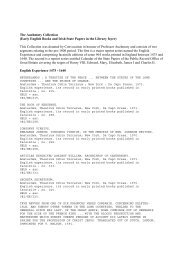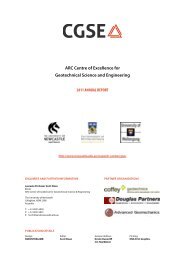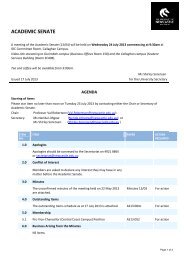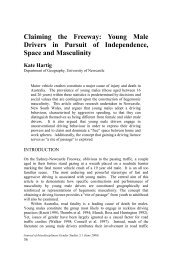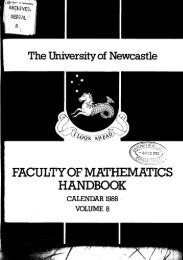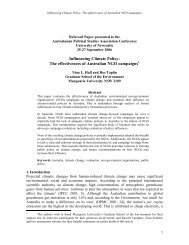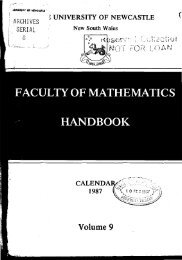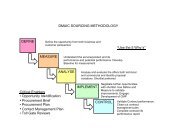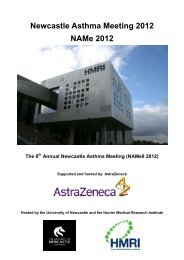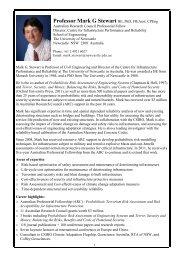AS AUSTRALIBh- LANGUAGE. I ' THE AIINTTINC: DIALECT FrER ES. 4 (6). SDFFISES TO VERBS. Inlpevntice n12d d$i,.nzntive FOYIILS. The imperative, in the Nin yug clialect, is the sirq)lest form <strong>of</strong> the verb ; it rill therefore be quotecl as the stein <strong>of</strong> the verb. In true verbs, it ends in -n or -e; as, kulga, 'cut,' bngge, ' fall.' If the -a or -e is cut <strong>of</strong>f, there remains the root <strong>of</strong> the verb, and to it the verbal sufixes are attacbecl. These are very numerous, and appear, at first sight, to be very complicated ; but tlle whole may be simplified bjr taking them in the following order :-(I) Final stfixes; (3) Internal strengthening particles or letters ; and (3) Separable clemonstrative particles. The usual final suffixes nrp :- 1. -a, -e, used iil ~iring a commaild or in expressing a wihh. 5. -nlcc, --aln, clenoting present action. 3. -an, clenoting future actiou. 4. -n?tne, -inne, -zcnne, clenoting unfinishecl past action. 5. -oro. cleliotinz finished action. " 6. -en,, the historical past tense ; <strong>of</strong>ten an aorist l)rtrt,iciple. 7. -ilz?ac~, usecl, but rarely, as a participle. 8. -inn, past time ; ~vith passive sense, when required. 9. -in, -2, -c&, when usecl with a leading verb, has a futurr meaning, but it is gsnerally the infinitive or noun form to esprexs verbal action. 10. -ni, may be callecl the subjunctive, but the verb cloes not take this form in all positions where me inight expect n subjunctive to be used. 11. -e?zcle?z, -zcncle?r, -cc?lcle?~, is probably clerix-ed froni kinder, the sixth form <strong>of</strong> which is kiqzclelz. It adds the idea <strong>of</strong> 'ntacle ' or 'did ' to the root iclea <strong>of</strong> the verb. It is sometimes equil-alent to the passive, and at times it becomes the foundation <strong>of</strong> another verb, so that there are such forms -e?zcletae, -e~~clelo~o, kc. It sometimes takes, between it and the root, the strengthening particles <strong>of</strong> the next paragraph. 15. The internal strengthening particles are (1) le, I, v, ye, (2) g, ny-g, iny-9, a.ncl (3) b. These are inserted between the root and and the final sax, ancl are sometimes con~pouncled together, so that there are such form as ganlle and balle. These particles add but little to the meaning. It may be that le or re gives a. sense <strong>of</strong> continuance to the action, so that while nln is a simple present, while ablcb may be a progressive present. This, however, is very doubtful. In fact, it may be stated, once for all, that while there is an abundance <strong>of</strong> forms, the aborigines do not seem to make rery exact distinctions in meaning between one form and anotl~er.
1 6 AN AUSTRALIAN LAFGU.4GE. If it is desired to give emphasis to the iclea that the action is con- tinuative, a separate word is usecl to denote this. Thus alelz, wilich is the strengthenecl form <strong>of</strong> en, is purely a participle with- out distinction <strong>of</strong> time. The forms in ?., I-e are simple variations <strong>of</strong> 19, and seldom usecl. The forms in g, ng-g, are from ga, 'to go on,' aud those in b from bn, ' to make,' ' cause to be.' The following table mill show the rarious possible forms in which a verb may be found. The separable demonstrative particles inserted in the tsble are :-he, bot, yun, de, ji. Bo ancl be seem to adcl notlung to the meaning ; yzob means ' there'; di or ji means ' to ' or 'at.' To the forms in italics, the separabb demonstrative particles are added. ,--Simple- , -Componncl. - "1. -a, -e, -ncle. -ale -ga. -pi& -ball&. 7 -el&. -errat. -g;a. -ggle. 2. -ah. -ela. -alela. -elel&. -gala. -g;ala. -cale!a. 9 -,galela. -bulela. -erralat. 3. -an. -anbe. -Ian. -rant. -ran. ? -=an. -alzji. 4. -anne. -inne. -alinne. -nklne. ? -gi me. -nalinine. -&alinne. -bulenne. -unne. 5. -oro. -aloro. -galore. -eloro. -&galore. 6. -en. -er~yzc?z. -nloroby. -allen. -arent. -wn. ? -ggen. -gnloroby. -uallen. ? -ggallen. -bulen. -bulelzji. -trllenji. -gel+ -gnlbl?ji. -buleny~lz. 7. -inns ; 8. -ian ; 9. -ia, -aia, -8 ; compouncl, -nlia ; 10. -ai ; compouncl, -bai ; 11. -enden ; compound, -genclen, -ggenden ; bunclen. "The numbers indicate the BIoods and Tenses ; thus, 1 is the I?nperatiue Jfood ; 2, The Present Tense ; 3, Tlie Future Tense ; 4, Il'lie Past (unjnished) ; 5, The Past (.f~ziahed) ; 6, A Participle form (<strong>of</strong>lsn past) : i, A Pal-ticiple fornt (generully pres~nt) ; 5, A Participle form (oj:en passive) ; 9, A AToz61t fornt <strong>of</strong> Fe~e, bal action (the i11jnitiz.e) ; 10, The Stib,'tlltctice, i.e., the .form which the verb takes when compo.u~tded with Azixilialy Verb9 ; 11, A Participle form (gertcrally passive.) 2, 3, 4, and 5 are <strong>of</strong> the Indicative &Iood. Besides these, there are some other compound verbal suffixes which are formed from indn and ?,$a, and from b and ba, as shown THE XISTUSC DIILECT. 17 IG~ZCZCL, ' make.' . his, as a principal rerb, has all the forms <strong>of</strong> the simple su$xes except KO. 11, ailcl many <strong>of</strong> the coi~lpouilcl ones ; as, kindn-bu lela, kincla-galoroby, kc. It son~etinles takes the form, thougl: rarely, <strong>of</strong> kigge, ancl, as such, enters into coll~position wit11 other verbs ; but the usual methocl <strong>of</strong> compounding it with verbs is to omit the k, and use only the terminations ; as, bo-al6, ' be great,' bo-inclal&, 'be n:acle great.' In the AIinyug dialect, when two words are brought together, it is common for the secoilcl to lose its initial consonant. lii,zcln itself is a deriratire from dch, mhich is in use to turn nouils and acljectives into verbs ; as, urnbin, 'a house,' um bin-cla, ' make a house.' Bcc, ' cause to be.' Zn, as a locative, is also a noun-su5ix, but, like dn, it helps tcr convert other morcls into verbs ; as, kirriba, 'awake.' As already noticed, it enters into composition rritll verbs, lengtheniilg their forms, at times, without aclcling to or altering their meaning. As part <strong>of</strong> a principal verb, it generally has the meaning <strong>of</strong> 'cause to be '; as, ny arry, ' a name,' ny arri-ba, ' give a name ' 01- ' cause to ha~e a name.' It is also attached to the past tense, and is <strong>of</strong>ten used when a secondary verb is in a seiltellce ; e.g., monno me bit ro kunjillinileban nobo, 'that fire mill be lightecl' (uncle to burn) to-morro\~.' -K7, 'make,' ' cause to be there,' 'cause' generally. This is one <strong>of</strong> the nlost important verbal suExes in the language. ,4s a nou~l-s~lEs, it has the sense <strong>of</strong> 'in,' ancl many <strong>of</strong> its derivative words have the iclea <strong>of</strong> rest in a place,' and not <strong>of</strong> causation. Jfaiffi means 'in a place,' while Laia meals 'go to a place.' Wain:aia means ' it is above '; waikaia, ' go above.' It is eviclent that l1zn originally meant both.' there ' ancl' cause to be ' generally.. But, after all, there is nothing strange in this. Eren no\v, with all the variation <strong>of</strong> forms, a good cleal <strong>of</strong> the meailing <strong>of</strong> n speaker depends upon the tone <strong>of</strong> the T-oice or the gesture <strong>of</strong> the hand. TVe call coilceive <strong>of</strong> a demonstrative as meaniag (1) 'there,' (5) 'go there,' (3) 'be there,' (4) 'cause to be there,' according to the tone <strong>of</strong> voice ancl the sulject <strong>of</strong> conversation. Ally acljective can take this suffix ; as, yily 61, ' sick,' y ily 61-ma. 'cause to be sick7; clukkai, 'dead,' dukai-ma, 'to Bill.' It enters into conlposition with adverbs <strong>of</strong> place as well ; as, with mai, ' above,' ancl kully, ku nd y, q.v., it gires maikalkullima, 'put crosswise,' waiknnclima, 'put on.' It sometimes follows acljectix-es ; as, bunyarra-ma yerritbil, ' make a good song7; and sometimes pronouns ; as, kaibi-ma junak, 'make another hiuldle.' With verbs, it is sometinles b
- Page 1 and 2:
AN AUSTRALIAN LANGUAGE AS SPOKEN BY
- Page 3 and 4:
- INTRODUCTION CONTENTS. . .. . . .
- Page 5 and 6:
X THE ILLUSTRATIONS. The New Englan
- Page 7 and 8:
H~V IRTEODUCTION. WTBODUCTIOR. xv i
- Page 9 and 10:
sriii IHTPODOCTIOX. It mar possibly
- Page 11 and 12:
xsii IBTBODUCTION. carried to Austr
- Page 13 and 14:
xxvi IPI-TBODUCTION. ha~e noticed i
- Page 15 and 16:
XSX IXTEODUCTION. ' tvo ' or ' seco
- Page 17 and 18:
I have no cloubt that this is the s
- Page 19 and 20:
and the Awabakal has a 'conjoined d
- Page 21 and 22:
degree of error, ~vhicll aEects als
- Page 23 and 24:
dPi INTBODCCTION. the numeral ' ten
- Page 26 and 27:
Xi 161RODUCTIO7S. use, the Latin su
- Page 28 and 29:
lri IHTI~ODCCTION. which they are j
- Page 30 and 31:
11 ISTBODGCTIOS. the Kelts, a ~ ery
- Page 32 and 33:
' fire.' They hare no circuiucision
- Page 34 and 35:
CVJIPREHESDIR'U THE PItISCIPLES AS1
- Page 36 and 37:
Jlaring resicled for manr years in
- Page 38 and 39:
Cudgel, Gammon, Gibber, Gummy, Goon
- Page 40 and 41:
The essential vorrels are 2, z", 22
- Page 42 and 43:
8 AN AUSTRALIAN L~GVAOE. THE GBIJIJ
- Page 44 and 45:
12 AN AVSTEALIAX LASGCAGE. to the a
- Page 46 and 47:
'n.1-VZ sa-ux ua-pRN soponog { "JON
- Page 48 and 49:
RECIPROCAL Pnoao~xs. Gatoa-bo, 'Iln
- Page 51 and 52:
OF THE PARTICIPLES. 1. The Pr~senf.
- Page 53 and 54:
30 AN AUSTBILIAW LBSGUAGE. PERAIISS
- Page 55 and 56:
Declension of this Verb, 11-11en it
- Page 57 and 58:
PARTICIPLES. T. 1. Tiir-bur-rill-iu
- Page 59 and 60:
SUBJ'OXCTTTE 3100~. T. 10. Tetti bu
- Page 61 and 62:
PREPOSITIONS. Ba, 'of [--deiloting
- Page 63 and 64:
%[he+- a curve in its orbit from an
- Page 65 and 66:
Kirrin, nz., paill. 11. Kdgka, nz.,
- Page 67 and 68:
Bfinmulliko, nz., to rob, to take G
- Page 69 and 70:
62 AN AUSTEALIA~Y LANGUAGE. Tetti-b
- Page 71 and 72:
GG LY AUSTRALIAN LL~YQUAGE. ILLUSTB
- Page 73 and 74:
70 AS AVSTX~LIIN LASGCIGE. ILLGST~A
- Page 75 and 76:
B 6 m mil n b i a b i - t i a ; nr.
- Page 77 and 78:
78 AN AUSTRILIAX LASGUIGE. . ILLEST
- Page 79 and 80:
Tunug unni Turkey-ko-ba; nt., this
- Page 81 and 82:
C [THE ORIGINAL TITLE-PAGE.] 6 A KE
- Page 83 and 84:
AX AUSTRALIAN LISGEAGE. As aborigin
- Page 85 and 86:
AX AUSTRALIA?? LANGUAGE. THE IKEY:
- Page 87 and 88:
9 -4 AN AUSTRALIAN LANGUAGE. The af
- Page 89 and 90:
98 All ATSTBALIAN LANGUAGE. . TIlE
- Page 91 and 92:
[The common root-words of the langu
- Page 93 and 94:
106 AN ATSTRALTAN LAXGUAOE. . SELEC
- Page 95 and 96:
110 AN AUSTRALIAN LANGUAGE. SELECTI
- Page 97 and 98:
114 AX AUSTRALIAYY LANBUAQE. Sectio
- Page 99 and 100:
Xectiolz 3. Palcoai-kan bag n~oron
- Page 101 and 102:
PART IT. -C THE GOSPEL BY ST. LUKE.
- Page 103 and 104:
THE AUTHOR'S PREFACE. IT i3 a matte
- Page 105 and 106:
THE GOSPEL BY LUGE, C. 1. 129 in mi
- Page 107 and 108:
133 AN AUSTRALIAN LANGUAGE. THE GOS
- Page 109 and 110:
136 AX AUSTRALIAN LbNGU-4GE. 15. Ga
- Page 111 and 112:
140 AX AUSTRALIAK LASGUAGE. tabirug
- Page 113 and 114: 144 -4s AUSTRALIAN LANGUAGE. THE GO
- Page 115 and 116: 14s AN 4USTRALIAN LANGGSGE. THE GOS
- Page 117 and 118: 253 AN AUSTRALIAN LANGUAGE. THE GOS
- Page 119 and 120: 156 AN AUSTRALILV LANGUAGE. THE GOS
- Page 121 and 122: 160 AN ilusTRaL1X-T LANGUAGE. THE G
- Page 123 and 124: 164 LY AUSTRALIAN LASGUAGE. THE COS
- Page 125 and 126: 19. Gatuu taraito wiyii, Guki116l11
- Page 127 and 128: 1;" AS bU3TRhLIbf LA-SC;TA(;E. TIIE
- Page 129 and 130: lifi AX ATSTEALIAS LASGCSGE. THE GO
- Page 131: 113 AX -4CSTG-4L1.$?3 LISGU~~GE. TH
- Page 134 and 135: 186 -4R AUSTR-kLIAN LAXGUAGE. THE G
- Page 136 and 137: 190 -hY AUSTRALIAX L~?~'Gus(~E. THE
- Page 138 and 139: AN AUSTRALIAN LAFGU-4GE. 35. Gat111
- Page 140 and 141: LEXICON GOSPEL r \ ~ TO ~ 8111ST ~
- Page 142 and 143: c1~l~~i.5. / [it. t!:?i.ist. ' il~~
- Page 144 and 145: 204 -45 BTSTEILXAN LA.KGUACE. Eredc
- Page 146 and 147: aos AS ACSTRZILIAN LLTGCAGE. Galili
- Page 148 and 149: I
- Page 150 and 151: 314 AX AUSTRALIAX LANGUAGE. THE LES
- Page 152 and 153: 21s -4X AUSTRALIAN LANGUAGE. THE LE
- Page 154 and 155: 222 9.3" A?\' ACSTRALIAR LANGU~GE.
- Page 156 and 157: 936 - - AX AGSTRALI.4X LANGCAGE. AI
- Page 158: APPENDIX. (4 A SHORT GRA3II~IA.R AN
- Page 161 and 162: S . A?: ACSTRILIAK LhKC;UA4GE. THE
- Page 163: The interrogatives seem to be the c
- Page 168 and 169: A ma11 calls an altlrr brotket. . .
- Page 170 and 171: 2 6 AN AUSTRALIAN LLYGUAC4F. 2. SEN
- Page 172 and 173: AX AUSTRALIAN LANGUAGE. PARBD~GX OF
- Page 174 and 175: AN AUSTRALIAK LAKGUAGE. The demoils
- Page 176 and 177: 3 8 AN AUSTRALIAX LANGUAGE. IUPERAT
- Page 178 and 179: By-2il~l-l)y-y~~l, palli, yurvunnk.
- Page 180 and 181: AN AVSTRALIAN LANGPAGE. (From Dr. M
- Page 182 and 183: 50 rn AUSTRALUN LANGUAGE. A child-g
- Page 184 and 185: I?~tperatives are :- Come here-kqma
- Page 186 and 187: THE WIUDHaEI DULECT. 59 The example
- Page 188: 63 AN AUSTRALIAN LANGUAGE. The conj
- Page 191 and 192: 6 8 A?? AUSTRALIAN LANGUAGE. Dzcnl
- Page 193 and 194: 73 AN AUSTRALIAN LANGUAGE. Bangalla
- Page 195 and 196: 7 6 AN AUSTRALIAN LANGUAGE. Bunbabi
- Page 197 and 198: 80 AN AUSTRALIAN L-LVGUAGE. THE VIl
- Page 199 and 200: 8 4 AN AUSTRALIAN LAXGUAGE. Gambung
- Page 201 and 202: I8 AN AUSTRALIAN LAXGUAGE. Gulgarra
- Page 203 and 204: 94 AX AGSTRALI-4N LASGUAGE. Kgarran
- Page 205 and 206: 96 AN AUSTRALIAN LASGUAGE. Karrari-
- Page 207 and 208: 100 AN AUSTRALIAN LANGUAGE. JIuogam
- Page 210 and 211: 106 AX AUSTRALIAN LAIYOUAGE. THE WI
- Page 212 and 213: 110 AN AUSTRALIAN LANGUAGE. [The sp
- Page 214 and 215:
114 AX AUSTRALIAN LAXGUAGE. n'gindu
- Page 216 and 217:
118 AN AUSTRALIAN LLBGUAGE. Nguigar
- Page 218 and 219:
P;giannigin Babbin, ngindu murrubir
- Page 220 and 221:
1. Yanoa wal bi tarai Eloi kaki yik
- Page 222 and 223:
G. Bdain buba murrign, buba wuncla&
- Page 224 and 225:
132 AX AUSTRALIAN LANGUAGE. FIRST S
- Page 226 and 227:
13G AN AUSTRALIAN LAKQUAGE. 7. 9 u-
- Page 228 and 229:
Won-nayn uiinoa yeterra? Trelkeld y
- Page 230 and 231:
Wea, be unne man-nun? man-nun bang;
- Page 232:
148 rn AUSTRALIAN LWBUAGE. Nun-form



